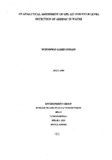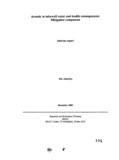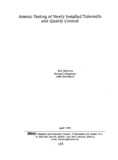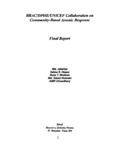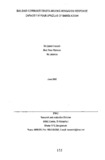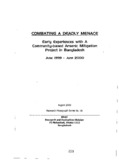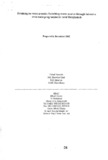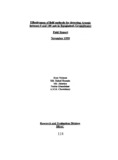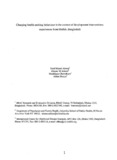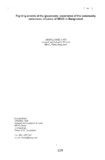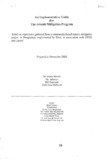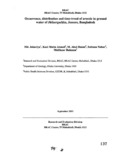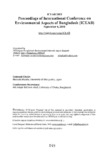Browsing by Subject "Arsenic"
Now showing items 1-20 of 22
-
An analytical assessment of GPL kit for field level detection of arsenic in water
(BRAC Research and Evaluation Division (RED), 1999-07)An attempt was taken to evaluate the suitability of GPL kit for field level detection of arsenic in water. The sources of variation in results of tests for arsenic determined by GPL kit seemed to be use of different sets ... -
Arsenic in drinking water and birth outcomes: a study of the Bangladesh Integrated Nutrition Programme
(BRAC Research and Evaluation Division (RED), 2004-09)This paper assesses the impact of arsenic (As) exposure on pregnancy outcomes in Bangladesh. A total of 261 villages from 3 highly As contaminated upazilas of two districts were selected for this study. The upazilas were ... -
Arsenic in tubewell water and health consequences: mitigation component
(BRAC Research and Evaluation Division (RED), 2003-12) -
Arsenic testing of newly installed tubewells and quality control
(BRAC Research and Evaluation Division (RED), 1999-04)The presence of arsenic in groundwater in Bangladesh has aroused widespread concern. It is estimated that over half of the Bangladesh population are at risk of arsenic poising. The source of arsenic in drinking water is ... -
Arsenicosis in Bangladesh: prevalence and sociodemographic correlates
(BRAC Research and Evaluation Division (RED), 2001)Arsenic contamination in drinking water has created concern for its potential health effects but our understanding of the risk factors of arsenicosis remains limited. This study assesses the prevalence of and soeio-demographic ... -
Assessing the effectiveness of the Shapla arsenic removal filter
(BRAC Research and Evaluation Division (RED), 2002-12)The study was conducted to assess the effectiveness of the Shap!a Arsenic Removal Filter. The two villages of Sonargaon Upazila were sel~cted , as the use of this filter was mainly concentrated there. A total of 50 Shapla ... -
Awareness and choice of options of Arsenic-free drinking water
(BRAC Research and Evaluation Division (RED), 2000)The discovery of arsenic contamination in tubewell water has created concern for its potential health effects. BRAC initiated an arsenic mitigation project in two upazilas in 1999. The project included promotion of ... -
BRAC/DPHE/UNICEF collaboration on community-based Arsenic response
(BRAC Research and Evaluation Division (RED), 1999)The severity of the problem of arsenic in ground water in Bangladesh is now well recognized. 97% of the population relics on ground water for drinking and cooking purposes and it is estimated that half of the country may ... -
Building community based arsenic mitigation response capacity in four upazilas of Bangladesh
(BRAC Research and Evaluation Division (RED), 2002-06)BRAC in collaboration with DPHE and 'UNICEF implemented the project entitled "Building community based arsenic mitigation response capacity" during July 2001 to June 2002 in four upazilas named Barura, Haimchar, Bahanga, ... -
Combating a deadly menace: early experiences with a community-based arsenic mitigation project in Bangladesh
(BRAC Research and Evaluation Division (RED), 2000-08)Bangladesh is facing the problem of arsenic poisoning in drinking water. Around 27% of the tubewells, which supply drinking water to most of the population, have arsenic concentrations above the government of Bangladesh ... -
Detection of trace amount of arsenic in groundwater by laser-induced breakdown spectroscopy and adsorption
(© 2014 Optics and Laser Technology, 2014)LIBS technique coupled with adsorption has been applied for the efficient detection of arsenic in liquid. Several adsorbents like tea leaves, bamboo slice, charcoal and zinc oxide have been used to enable sensitive detection ... -
Drinking no more arsenic: Switching water source through intensive awareness programme in rural Bangladesh
(BRAC Research and Evaluation Division (RED), 2002-12)The study assessed the effects of intensive awareness raising activities implemented from June 1999 to December 2001 among the arsenic exposed people to motivate towards safe water use. A total of 839 families those who ... -
Effectiveness of field methods for detecting Arsenic between 0 and 100 ppb in Bangladesh ground water
(BRAC Research and Evaluation Division (RED), 1999-11) -
Fighting arsenic at the grassroots: experience of BRAC's community awareness initiative in Bangladesh
(BRAC Research and Evaluation Division (RED), 2002)The study evaluates the arsenic mitigation project of BRAC in raising awareness of arsenic poisoning in rural communities in Bangladesh. Data came from selected project villages in south-western Bangladesh. Comparison villages ... -
Fighting arsenic at the grassroots: experience of the community awareness initiative of BRAC in Bangladesh
(BRAC Research and Evaluation Division (RED), 2001)The study evaluates the arsentc mitigation project of BRAC in ra1smg the awareness of arsenic poisoning in the rural communities in Bangladesh. Data came from the selected villages in the southwestern Bangladesh where ... -
An implementation guide for the Arsenic mitigation program
(BRAC Research and Evaluation Division (RED), 2002-11) -
Occurrence, distribution and time-trend of arsenic in ground water of Jhikorgachha, Jessore, Bangladesh
(BRAC Research and Evaluation Division (RED), 2003-09)In order to assess the arsenic concentration change over time, water from a total of 246 tubewells Jhikargachha upazila of Jessore district were tested using atomic absorption spectrophotometer in two different periods ... -
A Review of groundwater arsenic contamination in Bangladesh: the millennium development goal era and beyond
(© 2016 MDPI AG, 2016)Arsenic contamination in drinking water has a detrimental impact on human health which profoundly impairs the quality of life. Despite recognition of the adverse health implications of arsenic toxicity, there have been few ... -
Status of arsenic test and exposure to arsenic-contaminated tubewell water: a population-based study in Southern Bangladesh
(BRAC Research and Evaluation Division (RED), 2010-09)This study explores the status of arsenic test of tubewell and exposures to arsenic-contaminated tubewell water in the arsenic prone southern Bangladesh. Through a survey of 6,593 households, a total of 3,812 tubewells ... -
Sustainable community- based safe water options to mitigate the Bangladesh arsenic catastrophe - an experience from two upazilas
(BRAC Research and Evaluation Division (RED), 2003-05)Sustainable community-based safe water options have been successfully operating in two upazilas involving 531 villages and encompassing a population of 497,488. Testing of tubewells for arsenic was carried out on a census ...

